Discovery under construction
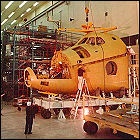 With NASA anticipating ramping up its launch schedule to more than one shuttle flight per month to meet demand for the vehicle’s unique satellite deployment and retrieval capabilities, construction begins on the third orbiter intended for spaceflight, Space Shuttle Discovery. Construction and checking of the third shuttle takes almost exactly four years, with Discovery’s first liftoff about a year later.
With NASA anticipating ramping up its launch schedule to more than one shuttle flight per month to meet demand for the vehicle’s unique satellite deployment and retrieval capabilities, construction begins on the third orbiter intended for spaceflight, Space Shuttle Discovery. Construction and checking of the third shuttle takes almost exactly four years, with Discovery’s first liftoff about a year later.

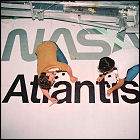 Construction begins on what is intended to be the fourth and final member of the current Space Shuttle fleet, Atlantis. With four orbiters in service, NASA will be one step closer to the routine, almost-weekly schedule of orbital flights envisioned in the Nixon-era mandate for the shuttle. Refinements and improvements in the process of constructing the shuttle fleet make Atlantis the lightest shuttle to date, over three tons lighter than Columbia.
Construction begins on what is intended to be the fourth and final member of the current Space Shuttle fleet, Atlantis. With four orbiters in service, NASA will be one step closer to the routine, almost-weekly schedule of orbital flights envisioned in the Nixon-era mandate for the shuttle. Refinements and improvements in the process of constructing the shuttle fleet make Atlantis the lightest shuttle to date, over three tons lighter than Columbia.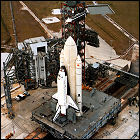 For the first time in the history of the delay-riddled Space Shuttle program, a complete, flight-ready vehicle is rolled out to the launch pad. Space Shuttle Columbia, atop the modified crawler vehicle which once carried Saturn V rockets to the pad, arrives at Cape Canaveral Launch Complex 39A, strapped to flight-qualified solid rocket boosters and a flight-ready external tank. (The shuttle Enterprise had been attached to empty boosters and tanks for fit checks as early as 1979.) Though preparation work continues to ready Columbia for flight, the shuttle is now in position for her first launch in 1981.
For the first time in the history of the delay-riddled Space Shuttle program, a complete, flight-ready vehicle is rolled out to the launch pad. Space Shuttle Columbia, atop the modified crawler vehicle which once carried Saturn V rockets to the pad, arrives at Cape Canaveral Launch Complex 39A, strapped to flight-qualified solid rocket boosters and a flight-ready external tank. (The shuttle Enterprise had been attached to empty boosters and tanks for fit checks as early as 1979.) Though preparation work continues to ready Columbia for flight, the shuttle is now in position for her first launch in 1981.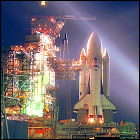 The first attempt to launch Space Shuttle Columbia on her maiden voyage is called off due to problems with the shuttle’s sophisticated system of redundant flight computers, some of which fail to synchronize with each other during the countdown. Over 24 hours are required to fix the bug, and the launch is delayed by two days.
The first attempt to launch Space Shuttle Columbia on her maiden voyage is called off due to problems with the shuttle’s sophisticated system of redundant flight computers, some of which fail to synchronize with each other during the countdown. Over 24 hours are required to fix the bug, and the launch is delayed by two days.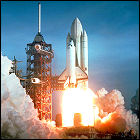
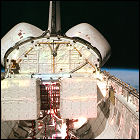 Safely in orbit, the cargo bay doors are opened for the first time on
Safely in orbit, the cargo bay doors are opened for the first time on 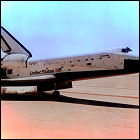 The first shuttle to return from space,
The first shuttle to return from space, 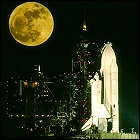 The second launch of Space Shuttle Columbia gets an unexpected one-month delay when a fuel leak forces NASA to remove, clean and re-attach 300 thermal tiles. The work can be done on-site, so Columbia simply stays on the pad. The second launch will be the last for the white external fuel tank, since NASA has determined that its brown insulating foam layer will cause no problems if left exposed; leaving off the coat of white paint saves several hundred pounds.
The second launch of Space Shuttle Columbia gets an unexpected one-month delay when a fuel leak forces NASA to remove, clean and re-attach 300 thermal tiles. The work can be done on-site, so Columbia simply stays on the pad. The second launch will be the last for the white external fuel tank, since NASA has determined that its brown insulating foam layer will cause no problems if left exposed; leaving off the coat of white paint saves several hundred pounds.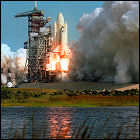 For the first time in history, a space vehicle returns to space for a second complete mission.
For the first time in history, a space vehicle returns to space for a second complete mission. 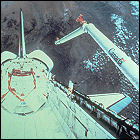 Key to NASA’s claim that the
Key to NASA’s claim that the 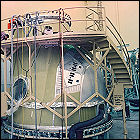 At Rockwell International, a spare Space Shuttle crew module is assembled alongside components intended for the orbiters Discovery and Atlantis, and though the spare isn’t intended for a specific shuttle yet to be built, it will find a purpose in the wake of the 1986 Challenger disaster: the spare crew module will become one of many completed shuttle spares that will eventually be assembled in the late 1980s as the Space Shuttle Endeavour, Challenger’s replacement and the last space shuttle constructed.
At Rockwell International, a spare Space Shuttle crew module is assembled alongside components intended for the orbiters Discovery and Atlantis, and though the spare isn’t intended for a specific shuttle yet to be built, it will find a purpose in the wake of the 1986 Challenger disaster: the spare crew module will become one of many completed shuttle spares that will eventually be assembled in the late 1980s as the Space Shuttle Endeavour, Challenger’s replacement and the last space shuttle constructed.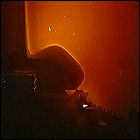 The testing phase of the shuttle program continues as Space Shuttle Columbia lifts off for her third flight into space. With Commander Jack Lousma and Pilot C. Gordon Fullerton aboard, Columbia stays in orbit for over a week, testing the orbiter’s endurance to heat at different angles to the sun, as well as testing the unmanned Spacelab experiment pallets in the cargo bay. This is the first shuttle flight to end on the contingency landing site at White Sands, New Mexico.
The testing phase of the shuttle program continues as Space Shuttle Columbia lifts off for her third flight into space. With Commander Jack Lousma and Pilot C. Gordon Fullerton aboard, Columbia stays in orbit for over a week, testing the orbiter’s endurance to heat at different angles to the sun, as well as testing the unmanned Spacelab experiment pallets in the cargo bay. This is the first shuttle flight to end on the contingency landing site at White Sands, New Mexico.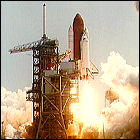 Space Shuttle Columbia lifts off for the fourth and final shuttle “test flight” before NASA’s Space Transportation System is declared fully operational. Remaining in orbit for a full week, Commander Ken Mattingly and Pilot Henry Hartsfield deliver the shuttle program’s first payload for the Department of Defense, as well as some of the first student-submitted experiment packages flown in the shuttle program. Both of Columbia’s solid rocket boosters, which are considered a reusable part of the launch vehicle, are lost at sea when their parachutes fail to deploy after separation and the boosters slam into the Atlantic Ocean; neither of the rockets are able to be recovered.
Space Shuttle Columbia lifts off for the fourth and final shuttle “test flight” before NASA’s Space Transportation System is declared fully operational. Remaining in orbit for a full week, Commander Ken Mattingly and Pilot Henry Hartsfield deliver the shuttle program’s first payload for the Department of Defense, as well as some of the first student-submitted experiment packages flown in the shuttle program. Both of Columbia’s solid rocket boosters, which are considered a reusable part of the launch vehicle, are lost at sea when their parachutes fail to deploy after separation and the boosters slam into the Atlantic Ocean; neither of the rockets are able to be recovered.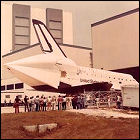 Completely refitted from a lightweight airframe originally fabricated for stress, vibration and thermal testing, Space Shuttle Challenger is rolled out of her Rockwell International assembly plant in Palmdale, California. Experience gained in the construction of Challenger’s sister ship, Columbia, means that the second completed shuttle in the fleet is over one ton lighter than Columbia. Challenger would make her first flight in just under a year.
Completely refitted from a lightweight airframe originally fabricated for stress, vibration and thermal testing, Space Shuttle Challenger is rolled out of her Rockwell International assembly plant in Palmdale, California. Experience gained in the construction of Challenger’s sister ship, Columbia, means that the second completed shuttle in the fleet is over one ton lighter than Columbia. Challenger would make her first flight in just under a year.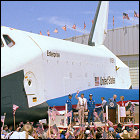 Space Shuttle Columbia lands at Edwards Air Force Base in California, making its first-ever landing on a concrete runway. After greeting the returning astronauts and inspecting the shuttle, President Ronald Reagan – with the partially-dismantled prototype Enterprise as a backdrop – declares NASA’s Space Shuttle system fully operational, saying “the test flights are over.” Columbia Commander Ken Mattingly later reveals that there was tremendous pressure on NASA to land Columbia on Independence Day, regardless of how many mission objectives had been met, to maximize the publicity value of the President’s speech. But the quick turnaround time and almost-weekly flight schedule that NASA had publicized throughout the 1970s is already a pipe dream: post-mission the four missions flown so far prove that post-landing servicing of each orbiter takes longer than expected. Columbia won’t fly again until the first “operational” mission in November.
Space Shuttle Columbia lands at Edwards Air Force Base in California, making its first-ever landing on a concrete runway. After greeting the returning astronauts and inspecting the shuttle, President Ronald Reagan – with the partially-dismantled prototype Enterprise as a backdrop – declares NASA’s Space Shuttle system fully operational, saying “the test flights are over.” Columbia Commander Ken Mattingly later reveals that there was tremendous pressure on NASA to land Columbia on Independence Day, regardless of how many mission objectives had been met, to maximize the publicity value of the President’s speech. But the quick turnaround time and almost-weekly flight schedule that NASA had publicized throughout the 1970s is already a pipe dream: post-mission the four missions flown so far prove that post-landing servicing of each orbiter takes longer than expected. Columbia won’t fly again until the first “operational” mission in November.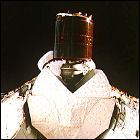 On the first fully-operational flight of NASA’s Space Transportation System, Space Shuttle Columbia delivers two commercial satellites to orbit, the Canadian Anik C-3 satellite and an American satellite, SitS-C. Aboard Columbia for this flight is the first four-astronaut crew in NASA’s history, consisting of Commander Vance Brand, Pilot Robert Overmyer, and mission specialists Joseph Allen and William Lenoir. The flight lasts five days before a landing at Edwards Air Force Base.
On the first fully-operational flight of NASA’s Space Transportation System, Space Shuttle Columbia delivers two commercial satellites to orbit, the Canadian Anik C-3 satellite and an American satellite, SitS-C. Aboard Columbia for this flight is the first four-astronaut crew in NASA’s history, consisting of Commander Vance Brand, Pilot Robert Overmyer, and mission specialists Joseph Allen and William Lenoir. The flight lasts five days before a landing at Edwards Air Force Base.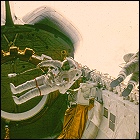 Space Shuttle Challenger lifts off into orbit for the first time, after extensive technical and mechanical issues keep the shuttle on the pad well past its original January launch date. The payload for this flight is NASA’s own TDRS (Tracking & Data Relay Satellite), designed to keep the shuttle in constant contact with ground controllers even if its orbit takes it out of direct communications. The five-day flight also sees the first spacewalk of the shuttle program. Challenger’s crew consists of Commander Paul Weitz, Pilot Karol Bobko, and mission specialists Donald Peterson and Story Musgrave.
Space Shuttle Challenger lifts off into orbit for the first time, after extensive technical and mechanical issues keep the shuttle on the pad well past its original January launch date. The payload for this flight is NASA’s own TDRS (Tracking & Data Relay Satellite), designed to keep the shuttle in constant contact with ground controllers even if its orbit takes it out of direct communications. The five-day flight also sees the first spacewalk of the shuttle program. Challenger’s crew consists of Commander Paul Weitz, Pilot Karol Bobko, and mission specialists Donald Peterson and Story Musgrave.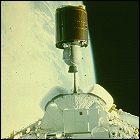 The second flight of Space Shuttle Challenger is a six-day mission to launch two more communications satellites (one for Canada and one for Indonesia), as well as featuring the first American woman in space (20 years behind the Soviet Union’s launch of Valentina Tereshkova). Challenger’s crew for this flight consists of Commander Robert Crippen, Pilot Frederick Hauck, and mission specialists John Fabian, Sally Ride and Norm Thagard.
The second flight of Space Shuttle Challenger is a six-day mission to launch two more communications satellites (one for Canada and one for Indonesia), as well as featuring the first American woman in space (20 years behind the Soviet Union’s launch of Valentina Tereshkova). Challenger’s crew for this flight consists of Commander Robert Crippen, Pilot Frederick Hauck, and mission specialists John Fabian, Sally Ride and Norm Thagard.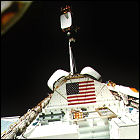 Taking off on a six-day satellite deployment mission, Space Shuttle Challenger also lifts the first African-American astronaut into orbit. A satellite deployment is carried out for India, along with continuing experiments to observe the performance of the shuttle in conditions of extreme cold with limited exposure to the sun. Aboard Challenger for this flight are Commander Richard Truly, Pilot Daniel Brandenstein, and mission specialists Dale Gardner, Guion Bluford, and William Thornton.
Taking off on a six-day satellite deployment mission, Space Shuttle Challenger also lifts the first African-American astronaut into orbit. A satellite deployment is carried out for India, along with continuing experiments to observe the performance of the shuttle in conditions of extreme cold with limited exposure to the sun. Aboard Challenger for this flight are Commander Richard Truly, Pilot Daniel Brandenstein, and mission specialists Dale Gardner, Guion Bluford, and William Thornton. Activision releases the
Activision releases the 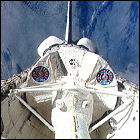 Returning to space after nearly a year of refits, Space Shuttle Columbia lifts off on the long-delayed first manned mission of the Spacelab laboratory module, which is installed in the cargo bay. (The nearly month-long delay was the result of a solid rocket booster issue that led to the first-ever return of the shuttle from the launch pad to the Vehicle Assembly Building.) The ten-day mission also boasts the first six-person shuttle crew, featuring the first Spacelab scientists from the European Space Agency, who have been training for this mission since the 1970s. Columbia’s crew includes Commander John Young, Pilot Brewster Shaw, mission specialists Owen Garriott and Robert Parker, and ESA payload specialists Byron Lichtenberg and Ulf Merbold.
Returning to space after nearly a year of refits, Space Shuttle Columbia lifts off on the long-delayed first manned mission of the Spacelab laboratory module, which is installed in the cargo bay. (The nearly month-long delay was the result of a solid rocket booster issue that led to the first-ever return of the shuttle from the launch pad to the Vehicle Assembly Building.) The ten-day mission also boasts the first six-person shuttle crew, featuring the first Spacelab scientists from the European Space Agency, who have been training for this mission since the 1970s. Columbia’s crew includes Commander John Young, Pilot Brewster Shaw, mission specialists Owen Garriott and Robert Parker, and ESA payload specialists Byron Lichtenberg and Ulf Merbold.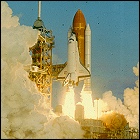 Space Shuttle Challenger lifts off on a satellite delivery mission, but the launches of both satellites go awry when their boosters (the Payload Assist Modules designed to launch satellites from the shuttle) put them in the wrong orbits. A German satellite is retrieved, repaired, and placed back into its orbit. A few days after launch, a member of Challenger’s crew will become the first free-floating human satellite. On this flight, Challenger’s crew consists of Commander Vance Brand, Pilot Robert Gibson, mission specialists Bruce McCandless, Ronald McNair and Robert Stewart. This is the first shuttle flight to end on the runway at Kennedy Space Center, eliminating the need for a costly, time-consuming 747 ferry flight to retrieve the shuttle from Edwards Air Force Base.
Space Shuttle Challenger lifts off on a satellite delivery mission, but the launches of both satellites go awry when their boosters (the Payload Assist Modules designed to launch satellites from the shuttle) put them in the wrong orbits. A German satellite is retrieved, repaired, and placed back into its orbit. A few days after launch, a member of Challenger’s crew will become the first free-floating human satellite. On this flight, Challenger’s crew consists of Commander Vance Brand, Pilot Robert Gibson, mission specialists Bruce McCandless, Ronald McNair and Robert Stewart. This is the first shuttle flight to end on the runway at Kennedy Space Center, eliminating the need for a costly, time-consuming 747 ferry flight to retrieve the shuttle from Edwards Air Force Base.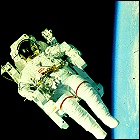 Astronaut Bruce McCandless becomes the first untethered human spacewalker when he leaves the cargo bay of Space Shuttle Challenger aboard a Manned Maneuvering Unit, a jetpack-like device allowing him to maneuver freely with no hoses or cables connecting him to the shuttle. In development since the Gemini era, and tested briefly aboard Skylab in prototype form, the MMU will see use on only three missions before NASA puts it in mothballs.
Astronaut Bruce McCandless becomes the first untethered human spacewalker when he leaves the cargo bay of Space Shuttle Challenger aboard a Manned Maneuvering Unit, a jetpack-like device allowing him to maneuver freely with no hoses or cables connecting him to the shuttle. In development since the Gemini era, and tested briefly aboard Skylab in prototype form, the MMU will see use on only three missions before NASA puts it in mothballs.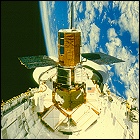 Space Shuttle Challenger lifts off on the first mission to retrieve a satellite in orbit, repair it, and release it back into that orbit. Launched in 1980, prior to the first shuttle mission, the Solar Maximum (Solar Max) Satellite is outfitted with a mechanism to allow the shuttle’s remote manipulator arm to grasp it; however, two astronauts using Manned Maneuvering Units still have to nudge it into Challenger’s cargo bay. With repairs completed, Solar Max is returned to its orbit, where it lasts until 1989. Challenger’s crew on this flight consists of Commander Bob Crippen, Pilot Francis Scobee, and mission specialists Geroge Nelson, James Van Hoften and Terry Hart.
Space Shuttle Challenger lifts off on the first mission to retrieve a satellite in orbit, repair it, and release it back into that orbit. Launched in 1980, prior to the first shuttle mission, the Solar Maximum (Solar Max) Satellite is outfitted with a mechanism to allow the shuttle’s remote manipulator arm to grasp it; however, two astronauts using Manned Maneuvering Units still have to nudge it into Challenger’s cargo bay. With repairs completed, Solar Max is returned to its orbit, where it lasts until 1989. Challenger’s crew on this flight consists of Commander Bob Crippen, Pilot Francis Scobee, and mission specialists Geroge Nelson, James Van Hoften and Terry Hart.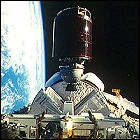 Space Shuttle Discovery makes its first flight into space on a mission to deploy three commercial communications satellites. Tested on this flight is a huge solar power panel which unfolds vertically from Discovery’s cargo bay, testing technology for space station designs still on the drawing board. Discovery’s crew for this flight consists of Commander Henry Hartsfield, Pilot Michael Coats, mission specialists Judy Resnick, Steven Hawley, Mike Mullane, and payload specialist Charles Walker.
Space Shuttle Discovery makes its first flight into space on a mission to deploy three commercial communications satellites. Tested on this flight is a huge solar power panel which unfolds vertically from Discovery’s cargo bay, testing technology for space station designs still on the drawing board. Discovery’s crew for this flight consists of Commander Henry Hartsfield, Pilot Michael Coats, mission specialists Judy Resnick, Steven Hawley, Mike Mullane, and payload specialist Charles Walker.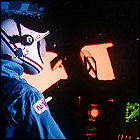 Space Shuttle Challenger lifts off on an eight-day mission, the first shuttle mission with a seven-person crew, which also happens to be the first American shuttle crew with two women on board. A satellite to study radiation around the Earth is deployed, along with an experiment to study the feasibility of refueling empty satellites to extend their service life. Challenger’s crew for this flight consists of Commander Robert Crippen, Pilot Jon McBride, mission specialists Kathryn Sullivan, Sally Ride, David Leestma and payload specialists Marc Garneau and Paul Scully-Power.
Space Shuttle Challenger lifts off on an eight-day mission, the first shuttle mission with a seven-person crew, which also happens to be the first American shuttle crew with two women on board. A satellite to study radiation around the Earth is deployed, along with an experiment to study the feasibility of refueling empty satellites to extend their service life. Challenger’s crew for this flight consists of Commander Robert Crippen, Pilot Jon McBride, mission specialists Kathryn Sullivan, Sally Ride, David Leestma and payload specialists Marc Garneau and Paul Scully-Power.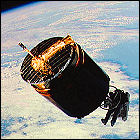 Space Shuttle Discovery takes off on a week-long satellite deployment mission, delivering a Canadian communications satellite and another American SYNCOM defense communications satellite into orbit. Using the MMU jet packs, Discovery’s crew retrieve two satellites placed into the wrong orbits by malfunctioning boosters after a shuttle mission earlier in the year, returning them to the cargo bay for return to Earth. Discovery’s crew consists of Commander Frederick Hauck, Pilot David Walker, and mission specialists Anna Fisher, Dale Gardner, and Joseph Allen.
Space Shuttle Discovery takes off on a week-long satellite deployment mission, delivering a Canadian communications satellite and another American SYNCOM defense communications satellite into orbit. Using the MMU jet packs, Discovery’s crew retrieve two satellites placed into the wrong orbits by malfunctioning boosters after a shuttle mission earlier in the year, returning them to the cargo bay for return to Earth. Discovery’s crew consists of Commander Frederick Hauck, Pilot David Walker, and mission specialists Anna Fisher, Dale Gardner, and Joseph Allen.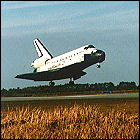 Space Shuttle Discovery lifts off on the shortest shuttle flight since the 1981 test flights, lasting only three days. A classified Defense Department payload is delivered to orbit, with the help of the first Inertial Upper Stage booster developed by the U.S. Air Force. This mission is the first time that shuttles had to be swapped out prior to flight – thermal tile issues on Challenger prevented that shuttle from being used for this mission – as well as the first instance of a shuttle launch scrubbed because of concerns over freezing weather and ice at the launch site. Discovery returns via the Kennedy Space Center runway, with Commander Ken Mattingly, Pilot Loren Shriver, mission specialists Ellison Onizuka and James Buchli, and payload specialist Gary Payton aboard.
Space Shuttle Discovery lifts off on the shortest shuttle flight since the 1981 test flights, lasting only three days. A classified Defense Department payload is delivered to orbit, with the help of the first Inertial Upper Stage booster developed by the U.S. Air Force. This mission is the first time that shuttles had to be swapped out prior to flight – thermal tile issues on Challenger prevented that shuttle from being used for this mission – as well as the first instance of a shuttle launch scrubbed because of concerns over freezing weather and ice at the launch site. Discovery returns via the Kennedy Space Center runway, with Commander Ken Mattingly, Pilot Loren Shriver, mission specialists Ellison Onizuka and James Buchli, and payload specialist Gary Payton aboard.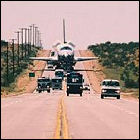 After four years of construction and an additional year of testing and checkout, the
After four years of construction and an additional year of testing and checkout, the 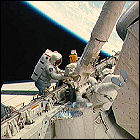 After a month of delays due to damage and a change in the flight schedule, Space Shuttle Discovery returns to orbit for a week-long flight. A Canadian communications satellite and the LEASAT-3 satellite are redeployed, but LEASAT continues to malfunction despite multiple attempts to active and launch it. Discovery’s crew on this flight consists of Commander Karol Bobko, Pilot Donald Williams, mission specialists Rhea Seddon, Jeffrey Hoffman and David Griggs, and payload specialists Charles Walker and Senator Jake Garn, the first member of the U.S. Congress to fly in space while in office. This flight’s return to the runway at Kennedy Space Center marks the first time a shuttle orbiter experiences significant damage upon landing, including a blowout of one of its landing gear wheels.
After a month of delays due to damage and a change in the flight schedule, Space Shuttle Discovery returns to orbit for a week-long flight. A Canadian communications satellite and the LEASAT-3 satellite are redeployed, but LEASAT continues to malfunction despite multiple attempts to active and launch it. Discovery’s crew on this flight consists of Commander Karol Bobko, Pilot Donald Williams, mission specialists Rhea Seddon, Jeffrey Hoffman and David Griggs, and payload specialists Charles Walker and Senator Jake Garn, the first member of the U.S. Congress to fly in space while in office. This flight’s return to the runway at Kennedy Space Center marks the first time a shuttle orbiter experiences significant damage upon landing, including a blowout of one of its landing gear wheels.